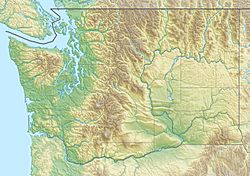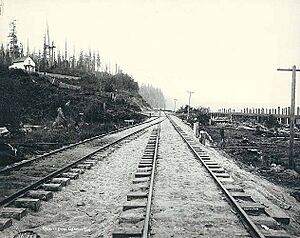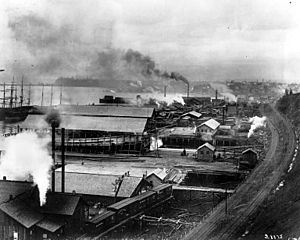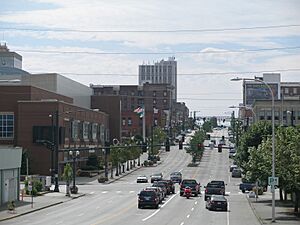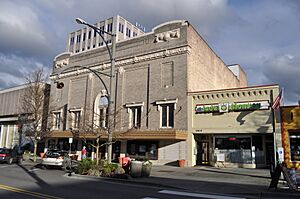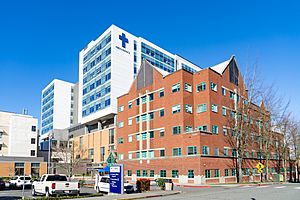Everett, Washington facts for kids
Quick facts for kids
Everett
dᶻəɬigʷəd
|
|||
|---|---|---|---|

Everett Station and the city skyline
|
|||
|
|||
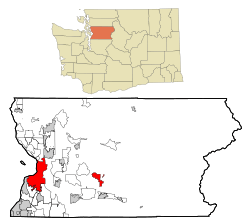
Location of Everett, Washington
|
|||
| Country | United States | ||
| State | Washington | ||
| County | Snohomish | ||
| Established | 1890 | ||
| Incorporated | May 4, 1893 | ||
| Government | |||
| • Type | Mayor–council | ||
| Area | |||
| • City | 47.91 sq mi (124.08 km2) | ||
| • Land | 33.19 sq mi (85.96 km2) | ||
| • Water | 14.71 sq mi (38.11 km2) | ||
| Population
(2020)
|
|||
| • City | 110,629 | ||
| • Estimate
(2023)
|
111,180 | ||
| • Rank | US: 280th WA: 7th |
||
| • Density | 3,358.6/sq mi (1,296.76/km2) | ||
| • Metro | 4,018,762 (US: 15th) | ||
| Demonym(s) | Everettite | ||
| Time zone | UTC−8 (Pacific (PST)) | ||
| • Summer (DST) | UTC−7 (PDT) | ||
| Zip codes |
98201, 98203, 98204, 98206, 98207, 98208, 98213
|
||
| Area code(s) | 425 | ||
| FIPS code | 53-22640 | ||
| GNIS feature ID | 1512198 | ||
Everett is a city in Washington State, USA. It is the main city in Snohomish County and its county seat. Everett is about 25 miles (40 km) north of Seattle. It is one of the largest cities in the Seattle area.
As of 2020, Everett had 110,629 people living there. This makes it the seventh-most populated city in Washington. The city sits on a piece of land called a peninsula. This land is at the mouth of the Snohomish River and along Port Gardner Bay. This bay is part of Puget Sound.
For thousands of years, the Snohomish people lived on the Port Gardner Peninsula. Their main village was called Hibulb. Modern settlement began in the 1860s with loggers. In 1890, a group of investors decided to build a large industrial city here. They named it "Everett" after Everett Colby, the son of one of the investors.
Everett became an official city in 1893. This was soon after the Great Northern Railway arrived. The city grew as a major lumber center with many large sawmills. In 1897, Everett became the county seat after a long disagreement with the city of Snohomish.
After World War II, Everett's economy changed. It moved from lumber to aerospace. Boeing built a large aircraft assembly plant at Paine Field in 1967. Boeing is still the city's biggest employer. The U.S. Navy also has a base here, Naval Station Everett, which opened in 1994.
Everett is an important place for jobs in Snohomish County. Many people also live here and travel to Seattle for work. The city is connected to Seattle by Interstate 5 and public transport. This includes the Sounder train and Amtrak at Everett Station. Everett also has fun annual festivals and minor league sports teams. These include the Everett Silvertips hockey team and the Everett Aquasox baseball team.
Contents
Everett's History: A Journey Through Time
Early Days: The Snohomish People
The first people arrived in the Puget Sound area about 12,000 years ago. The oldest signs of people living in what is now Everett are from about 2,000 years ago. The Snohomish people had many villages. Their main village, called Hibulb, was at Preston Point. This was near the mouth of the Snohomish River.
Hibulb was a very important village. It had a strong cedar fence to protect it from attackers. It was one of the largest Snohomish villages. It also had the biggest potlatch house. There were also four other large cedar longhouses, each about 100 feet (30 meters) long.
According to Snohomish stories, their creator, dukʷibəɬ, placed them at Hibulb. This was their original home. In the early 1800s, diseases like smallpox greatly reduced the Snohomish population. Later, a huge landslide in the 1820s caused a tidal wave. This wave almost destroyed Hibulb, but the village recovered.
In 2013, the City of Everett and the Tulalip Tribes put up signs at Legion Park. These signs show pictures of the village and tell its history. The park is on a bluff overlooking the old village site.
How Everett Got Started
The first Europeans came to this area in 1792. They were explorers from the Vancouver Expedition. They landed on the beach and claimed the land for England. Later, the Hudson's Bay Company and the United States Exploring Expedition explored the area.
The Snohomish people signed the Treaty of Point Elliott in 1855. This treaty gave their lands to the Washington government. Many Snohomish people moved to the nearby Tulalip Reservation. The first American settler, Dennis Brigham, arrived in the 1860s. He built a cabin and claimed land. Other families also settled here.
In 1890, two men, Henry Hewitt Jr. and Charles L. Colby, planned to build a big industrial city. They thought this spot would be the first ocean port for the Great Northern Railway. They wanted to make it a "Pittsburgh of the West." They named the city "Everett" after Colby's son.
The Everett Land Company was formed in 1890. It bought a lot of land. By 1891, Everett had its first businesses. A post office opened in July. The Seattle and Montana Railroad was built in October. By the end of 1891, Everett had a school, a saloon, a church, and a sawmill.
The Great Northern Railway was completed in 1893. However, it did not end in Everett as hoped. It continued to Seattle.
Becoming an Official City
The Everett Land Company allowed the city to form its own government. On April 27, 1893, the people of Everett voted to become an official city. They elected Thomas Dwyer as their first mayor. The city's streetcar system started on July 3, 1893. It connected the main business area to mills and other parts of the city.
The Everett Land Company faced money problems in 1893. This was due to a big economic crisis. Many businesses closed. However, some projects continued. The City of Everett, a large ship, was launched in 1894. The Everett Women's Book Club started in 1894. They opened the city's first hospital and public library.
Everett continued to grow. Lumber activities increased. New mineral discoveries helped the city boom. The city also benefited from the Klondike Gold Rush.
Everett wanted to become the county seat. This meant it would be the main government city for the county. In 1894, an election was held. Everett won, but there were arguments about cheating. After a long legal fight, the Washington Supreme Court decided in October 1895 that Everett would be the county seat. In January 1897, county records were moved to Everett. A new courthouse opened in 1898.
Everett: The Milltown Era
In 1899, the Everett Improvement Company took over the Everett Land Company's properties. Friedrich Weyerhäuser chose Everett for his large lumber mill, which opened in 1902. By 1910, Everett had 11 lumber mills and many shingle mills. It was known as "Milltown" because of all the factories.
Everett became a first-class city in 1907. Its population reached almost 25,000 by 1910. The lumber business did well after the 1906 San Francisco earthquake. There was a high demand for wood to rebuild San Francisco. Everett had a big fire in 1909 that destroyed many buildings. But the city quickly rebuilt.
Workers in Everett started forming labor unions in the early 1900s. They wanted better pay and safer conditions. In 1916, there was a deadly event called the Everett massacre. This was a conflict between workers and others. After this, laws were passed to prevent people from promoting violence.
Growth Between the Wars

The timber industry continued to boom and bust in the 1920s. The Port of Everett was created in 1918. This helped the city control its waterfront and grow its economy. The city also got a new water supply from the Sultan River in 1919.
Downtown Everett grew a lot in the 1920s. Many new office buildings and stores were built. The six-story Monte Cristo Hotel opened in 1925. It had 140 rooms and a banquet hall. The first radio station in the county, KFBL, started broadcasting in 1922.
More people started using cars. This led to new roads being built. The Stevens Pass Highway opened in 1925. The Pacific Highway was completed in 1927. Everett was one of the first cities to replace its streetcars with buses in 1923.
During the Great Depression, many people in Everett lost their jobs. The federal government's Works Progress Administration helped. They hired local workers to build a new library, parks, and improve streets. A new county airport, Paine Field, opened in 1936. It was used by the military during World War II.
Boeing and Modern Everett
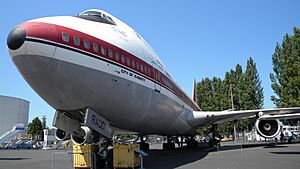
After World War II, downtown Everett continued to grow as a shopping center. The city's population grew quickly. New homes and schools were built. Everett Memorial Stadium was built in 1947 for high school sports.
The first suburban-style supermarket opened in 1950. More shopping centers and big stores followed. Everett expanded its city limits by adding nearby areas. By 1972, the city's population was over 50,000. Interstate 5 opened in 1965. It connected Everett to Seattle.
Boeing opened its first Everett factory in 1943. By 1965, it was the city's largest employer. In 1966, Boeing bought land near Paine Field to build a huge factory. This factory would assemble the Boeing 747 passenger jet. The first 747, named the "City of Everett," was unveiled in 1968. The Everett factory grew to build other Boeing planes like the 767, 777, and 787.
The Boeing plant brought new homes and businesses to Everett. A new freeway, State Route 526, was built to connect the plant to Interstate 5. The Everett Mall opened in 1974.
In the 1970s, many of Everett's lumber mills closed. The city focused more on aerospace and technology. Companies like Hewlett-Packard and Fluke opened facilities here. Downtown Everett also saw changes as stores moved to suburban areas.
Boeing's Everett plant grew again in the 1980s. The U.S. Navy chose Everett for a new military base in 1984. Naval Station Everett opened in 1994. It became home to several aircraft carriers.
Everett's downtown area started to improve in the 1990s. The Boeing plant expanded again for the 777 program. The world's largest building by volume grew even bigger. New buildings and renovated historic ones appeared downtown. Everett was named an All-America City in 2002.
Everett became a key transport hub for the regional Sound Transit system. Everett Station opened in 2003. It serves Amtrak trains, Sounder commuter rail, and buses. Interstate 5 was rebuilt and improved from 2005 to 2008.
Downtown Everett continued to develop in the 2000s and 2010s. The Angel of the Winds Arena opened in 2003 for sports and events. New hotels and apartment buildings were built. The city also added supportive housing for people experiencing homelessness.
Boeing continued its work in Everett with the 787 Dreamliner and 747-8 programs. The Future of Flight Aviation Center & Boeing Tour, an aviation museum, opened in 2005. Commercial flights from Paine Field started again in 2019.
New Developments in Everett
The city began planning to redevelop the waterfront along the Snohomish River. This project includes homes, shops, offices, and parks. Another development, Waterfront Place, started in 2018. It has a hotel, apartments, restaurants, and shops near the city's marina.
Providence Regional Medical Center Everett, the city's main hospital, expanded in 2011. In 2020, the first U.S. case of COVID-19 was identified in Snohomish County. The mayor declared a "shelter-in-place" order.
New homes and apartments continue to be built in downtown Everett and on the waterfront. There are also plans to redevelop the Baker Heights public housing complex into a mixed-income neighborhood.
Everett's Location and Landscape
Everett is a main city in the Seattle metropolitan area. It is about 25 miles (40 km) north of Seattle. The city is mostly on the Port Gardner Peninsula. To the west is Port Gardner Bay, part of Puget Sound. To the north and east is the Snohomish River delta.
Everett also includes suburban and industrial areas to the south and southwest. These areas were added to the city over time. Everett has 11 miles (18 km) of freshwater shoreline and 11 miles (18 km) of saltwater shoreline. This includes parks and boat ramps. The city covers about 48.49 square miles (125.6 km2). About 33.45 square miles (86.6 km2) is land and 15.04 square miles (38.9 km2) is water.
The city's western border is near Mukilteo. The southwestern edge borders Paine Field. The southern border goes around Silver Lake. The Snohomish River forms most of the eastern border. Bridges connect Everett to Marysville and Lake Stevens. The city also owns 3,729 acres (1,509 ha) of forest around Lake Chaplain. This lake provides part of the city's water.
Everett is near the Southern Whidbey Island Fault. This is an earthquake fault line. The city has an emergency management office. It practices for possible disasters.
Everett's Neighborhoods
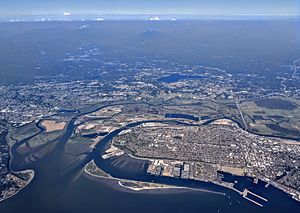
Everett has an Office of Neighborhoods. This office helps the city talk with local neighborhood groups. These groups are independent and have their own leaders. Many neighborhoods in Everett have great views of the Cascade and Olympic mountains. This includes Mount Baker and Mount Rainier.
As of 2019, Everett has 19 recognized neighborhood associations. Some of these include:
- Bayside: This area includes most of Downtown Everett, the Port of Everett, and Naval Station Everett.
- Lowell: This is a residential area southeast of downtown. It used to be its own town.
- Northwest Everett: This area has older homes, a historic district, and the Everett Community College campus.
- Port Gardner: This includes parts of Downtown Everett and homes on Rucker Hill.
- Silver Lake: This area has homes and businesses around Silver Lake in the southeastern part of the city.
Downtown Everett: The City's Heart
Downtown Everett is the area north of Pacific Avenue, east of West Marine View Drive, south of Everett Avenue, and west of Broadway. It has city and county government offices. There are also tall office buildings, hotels, and apartments. The Angel of the Winds Arena is here. Many downtown streets are named after the city's founders.
In 2018, the city allowed taller buildings, up to 25 stories, downtown. This was to encourage more development. In the early 2020s, many new apartment buildings were completed downtown and on the waterfront.
Everett's Weather and Climate
Everett has an oceanic climate. This means it has moderate temperatures all year. Summers are dry, and winters are mild and rainy. This is because it is close to the Pacific Ocean. Everett is at the north end of the Puget Sound Convergence Zone. This weather pattern can bring more rain and stronger winds.
August is usually the warmest month. The average high temperature is about 72.7°F (22.6°C). January is the coolest, with an average high of 44.9°F (7.2°C). The highest temperature ever recorded was 100°F (38°C) in 2009, 2020, and 2021. The lowest was 0°F (-18°C) in 1993.
Everett gets about 35.71 inches (907 mm) of rain each year. Most of this rain falls from October to March. December is the wettest month. Heavy snowfall is rare in Everett. The most snow ever recorded was 26.6 inches (68 cm) in 1965.
Everett's Economy and Jobs
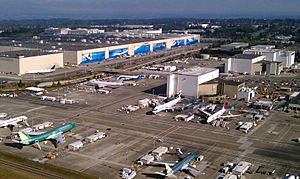
Everett has a large workforce. In 2018, about 59,599 people were employed in the city. Everett's economy focuses on making airplanes, shipping, technology, and services.
The biggest employer in Everett is Boeing. About 31% of all jobs are with Boeing. Their main factory near Paine Field is the largest building in the world by volume. Boeing's success greatly affects Everett's economy.
In the past, Everett's economy was all about lumber and shipping. The last wood pulp mill closed in 2012. This marked the end of the lumber industry's main role. The aerospace industry grew in the late 1960s after Boeing built its plant. This brought many other aerospace companies to the area.
Since the 1990s, Everett has worked to bring in other types of businesses. This includes technology companies. The Port of Everett has an industrial park. It has a Boeing supplier and distribution centers for Amazon and FedEx.
As of 2018, the largest industries in Everett are manufacturing (18% of jobs), education (18%), and retail (12%). Fluke Corporation, an electronics maker, is based in Everett. Toymaker Funko is also headquartered downtown. MagniX, an electric motor company, moved its headquarters to Everett in 2021. TerraPower opened a research facility near Paine Field in 2020. They are developing smaller nuclear reactors.
Other big employers include Providence Regional Medical Center Everett (4,900 employees), the U.S. Navy (2,900 employees), and Everett Public Schools (2,440 employees).
Many people who work in Everett live in other cities. About 15% of Everett workers live in Seattle. Most people (70%) drive alone to work. About 14% carpool, and 6% use public transportation.
Everett has many stores. They are mostly along Evergreen Way and Everett Mall Way. The Everett Mall opened in 1974. It has over 100 stores.
Top Employers in Everett
| Rank | Employer | Number of employees |
|---|---|---|
| 1 | Boeing | 35,000 |
| 2 | Providence Regional Medical Center Everett | 4,906 |
| 3 | State of Washington | 3,000 |
| 4 | Naval Station Everett | 2,900 |
| 5 | The Everett Clinic | 2,871 |
| 6 | Snohomish County | 2,759 |
| 7 | Everett Public Schools | 2,443 |
| 8 | Fluke Corporation (Fortive) | 1,200 |
| 9 | City of Everett | 1,198 |
| 10 | Snohomish County Public Utility District | 1,004 |
Everett's People and Demographics
Everett is the largest city in Snohomish County. It is the seventh largest in Washington state. In 2020, 110,629 people lived in Everett. The city's population grew a lot from 1990 to 2010. This was due to adding new areas and building more homes. Everett is expected to grow by 40,000 to 60,000 residents by 2035.
The city's population growth since 1990 has mainly been from non-Caucasian groups. The percentage of white residents decreased from 92% in 1990 to 58.57% in 2020.
In 2010, Everett had 41,312 households. About 30.5% of households had children under 18. The average household size was 2.39 people. The average family size was 3.09 people.
The average age in Everett in 2010 was 34.4 years. About 22.7% of residents were under 18. About 10.3% were 65 or older. The city had slightly more males (50.9%) than females (49.1%).
Everett has one of the lowest homeownership rates in Washington. Only 44% of homes are owned by the people living in them. The average rent for housing in Everett in 2013 was between $700 for a studio and $2,723 for a five-bedroom home. The city also has affordable housing for low-income families.
| Race / Ethnicity (NH = Non-Hispanic) | Pop 2000 | Pop 2010 | Pop 2020 | % 2000 | % 2010 | % 2020 |
|---|---|---|---|---|---|---|
| White alone (NH) | 71,276 | 70,489 | 64,791 | 77.91% | 68.42% | 58.57% |
| Black or African American alone (NH) | 2,966 | 3,921 | 5,716 | 3.24% | 3.81% | 5.17% |
| Native American or Alaska Native alone (NH) | 1,302 | 1,129 | 925 | 1.42% | 1.10% | 0.84% |
| Asian alone (NH) | 5,710 | 7,949 | 10,485 | 6.24% | 7.72% | 9.48% |
| Pacific Islander alone (NH) | 299 | 712 | 1,439 | 0.33% | 0.69% | 1.30% |
| Other Race alone (NH) | 150 | 170 | 591 | 0.16% | 0.17% | 0.53% |
| Mixed Race or MultiRacial (NH) | 3,246 | 4,054 | 7,599 | 3.55% | 3.94% | 6.87% |
| Hispanic or Latino (any race) | 6,539 | 14,595 | 19,083 | 7.15% | 14.17% | 17.25% |
| Total | 91,488 | 103,019 | 110,629 | 100.00% | 100.00% | 100.00% |
Everett's Culture and Fun
Arts and Entertainment in Everett
Everett is known as a "blue-collar city." But it also has a lively arts scene. This includes art galleries, community theaters, and music. The city has five main places for performing arts.
The Historic Everett Theatre opened in 1901. It has 834 seats. It hosts plays, music, comedy, and movies. The Village Theatre performs at the Everett Performing Arts Center. This city-owned building opened in 1993. The Village Theatre also opened KidStage in 2011 for young performers. The Everett Philharmonic Orchestra plays at the Everett Civic Auditorium.
Everett has a public art program. It is managed by the Everett Cultural Arts Commission. They also manage 16 street pianos downtown. Local artists paint these pianos. The main arts district is on Hoyt Avenue downtown. The Schack Art Center opened here in 2011. It is a place for art exhibits and workshops. It has helped make downtown more lively.
Everett has been featured in movies and TV shows. The 2014 film 7 Minutes was set here. Parts of the TV series Twin Peaks were filmed in an Everett house.
Events and Tourist Spots
Everett hosts many annual events and festivals. Most of these happen in the summer. The city has a fireworks show on July 4th. There is also a downtown parade. Everett has hosted a sausage and street festival every September since 1977.
Other festivals include a film festival in February. The Cruzin' to Colby classic car show is in May. The Sorticulture garden festival is in June. The Fresh Paint art show is in August.
The Everett Farmers Market started in 1994. It is open on Sundays from May to October. It has 200 vendors and about 5,000 visitors each week. It moved to Wetmore Avenue downtown in 2019. The waterfront also has a summer concert series.
The city government and the Everett Downtown Association promote tourism. They have created new events. A craft beer festival started in 2012. The Fisherman's Village Music Festival happens every May. It features local and national artists. An annual 3-on-3 basketball tournament started in 2022. Everett's first Pride parade was held in 2023.
Everett has several major tourist attractions. Many are about aviation. The Future of Flight Aviation Center & Boeing Tour at Paine Field has aviation exhibits. It also offers tours of the Boeing factory. It is the most popular tourist spot in Snohomish County. The Flying Heritage & Combat Armor Museum has old military planes and vehicles. The Imagine Children's Museum opened in 2004. It has interactive exhibits for kids about history, science, and art.
Media in Everett
The Everett Herald is the city's daily newspaper. It provides local and national news. It started in 1901. The Herald launched its website in 1997. It also publishes a monthly business journal and a weekly Spanish-language newspaper.
Everett is part of the Seattle–Tacoma media market. This includes many TV and radio stations. KONG-TV, a Seattle TV channel, is licensed to Everett. The City of Everett also has The Everett Channel. This TV station broadcasts local events and city meetings.
Everett has four radio stations. KRKO-AM plays classic hits and local sports. KKXA-AM plays country music. KSER-FM is a public radio station. It has local news and music. KWYZ-AM broadcasts in Korean.
Libraries in Everett
The Everett Public Library system has two locations. It has over 258,000 items. It serves more than 45,000 members. The library started in 1894. The main downtown library opened in 1934. A branch library in South Everett opened in 1985.
Historic Places in Everett
Everett has 14 properties listed on the National Register of Historic Places. The city also has its own list of historic places. A group called Historic Everett works to preserve the city's history. They offer tours and educational events.
The city has several historic districts. These include the Hewitt Avenue Historic District and the Rucker Hill Historic District. Many historic buildings have been restored.
The Everett Museum of History was founded in 1953. It plans to open a new museum in 2021. It will be in the former Everett Herald offices downtown.
Sports in Everett
Everett has two sports venues. They are used by professional minor league teams and for other events. The Angel of the Winds Arena is an indoor arena downtown. It seats 8,149 people. It is home to the Everett Silvertips hockey team. The arena opened in 2003. It also has an ice rink for the community and a convention center.
The Everett AquaSox baseball team plays at Funko Field. This stadium seats 3,682 people. It is part of the Everett Memorial Stadium complex. The complex also has a football and track stadium. The Aquasox plan to renovate Funko Field or build a new stadium downtown.
Everett used to have other indoor sports teams. These included basketball and arena football teams. A new Arena Football League team, the Washington Wolfpack, plans to start playing in 2024.
The city has also hosted minor league soccer teams. The Everett Jets FC is an amateur soccer team. They started playing in 2021. The Seattle Spartans are a women's football team. They play their home games at Mariner High School.
| Club | Sport | League | Existed | Venue | Championships |
|---|---|---|---|---|---|
| Everett AquaSox | Baseball | Northwest League | 1984–present | Funko Field | 1985, 2010 |
| Everett Hawks | Arena football | Indoor Football League | 2002–2007 | Everett Events Center | |
| Everett Jets FC | Soccer | Evergreen Premier League | 2021–present | Archbishop Murphy High School | |
| Everett Raptors | Arena football | National Indoor Football League, af2 | 2012 | Comcast Arena | |
| Everett Silvertips | Hockey | Western Hockey League | 2003–present | Angel of the Winds Arena | |
| Seattle Spartans | American football | Women's Football Alliance | 2012–present | Mariner High School | |
| Snohomish County Explosion | Basketball | International Basketball League, National Athletic Basketball League | 2007–2010 | Angel of the Winds Arena | |
| Washington Stealth | Box lacrosse | National Lacrosse League | 2010–2013 | Comcast Arena | 2010 |
| Washington Wolfpack | Arena football | Arena Football League | 2023–present | Angel of the Winds Arena |
Parks and Recreation in Everett
Everett has over 40 parks, trails, golf courses, and playgrounds. These are managed by the city's Parks and Recreation Department. The department takes care of 693 acres (280 ha) of land. Most of it is for nature, and some is for people to use. The department also organizes sports leagues, swimming lessons, and other activities.
The city's first park, Clark Park, was created in 1894. The largest park, Forest Park, was acquired in 1894. The parks system has many sports fields and courts. The city runs two public golf courses.
Everett has public access to the shoreline at Howarth Park, Rotary Park, and Langus Riverfront Park. These parks have beaches and boat launches. The Port of Everett has a large public marina. It also has a ferry to Jetty Island. The city also maintains a section of the Interurban Trail. This trail connects Everett to other cities like Lynnwood and Seattle.
Everett's senior center opened in 1965. It was later renamed for Carl Gipson, the city's first African American council member. The senior center closed temporarily in 2020 due to the COVID-19 pandemic. It reopened in 2022.
Major Parks to Explore
Forest Park is the largest park in Everett. It covers 197 acres (80 ha). It has hiking trails and recreational facilities. A public zoo was once at Forest Park, but it closed in 1962. Many of the park's main facilities were built in the 1930s. A public swimming pool opened in 1976.
American Legion Memorial Park is a large open space in North Everett. It covers 140 acres (57 ha). Most of the park is a golf course. The Evergreen Arboretum was built here in 1963. There is also a viewpoint called Hibulb Lookout. It has views of the Olympic Mountains.
Jetty Island is an artificial island in Port Gardner Bay. It has sandy beaches and protected wildlife areas. The island was created from dredging the Snohomish River. The city runs a seasonal ferry to the island from July to September. Jetty Island is home to over 115 bird species and salmon habitats.
Education in Everett
Everett's public schools are managed by Everett Public Schools. The district has 26 schools and 20,000 students. It covers most of Everett and the city of Mill Creek. Some southern and western neighborhoods of Everett are served by the Mukilteo School District.
Everett Public Schools has three high schools: Everett High School, Cascade High School, and Henry M. Jackson High School. The district is known for its high graduation rates. There are also five middle schools and 18 elementary schools. Two alternative schools are Sequoia High School and ACES High School.
Everett also has several private schools. Many are run by religious groups. The largest private high school in the county is Archbishop Murphy High School.
Colleges and Universities
Everett Community College (EvCC) is a two-year public college. It has 19,000 students. The main campus is in North Everett. It opened in 1941 and moved to its current location in 1958.
Leaders in Everett wanted a four-year college. In 2017, Washington State University Everett opened. It is a branch campus of WSU. It is next to the EvCC campus. Western Washington University also has a branch at EvCC.
Everett also has private and specialized colleges. These include City University and Everest College. Embry–Riddle Aeronautical University has a campus near the Boeing plant. Columbia College has a campus at Naval Station Everett.
Everett's Infrastructure
Getting Around Everett

Interstate 5 (I-5) runs through Everett. It connects the city to Seattle and Vancouver, Canada. The I-5 section between Everett and Seattle is very busy.
Everett also has other major highways. U.S. Route 2 goes to Wenatchee. State Route 99 goes to Seattle. State Route 526 goes to Mukilteo. State Route 527 goes to Mill Creek. State Route 529 goes to Marysville.
Everett Station is a major transportation hub. It opened in 2002. It serves Amtrak trains, Sounder commuter rail, and intercity buses. The Sounder train connects Everett to Seattle.
The city has its own bus system, Everett Transit. It started in 1969. The countywide Community Transit system also serves Everett. It has bus rapid transit lines called Swift. These lines travel through the city. Sound Transit plans to extend Link light rail service to Paine Field by 2037 and Downtown Everett by 2041.
Everett has 53 miles (85 km) of bike lanes. It also has 13 miles (21 km) of bike trails. The Interurban Trail is a major bike and walking trail. It starts in Everett and goes south to Seattle. The city has also had scooter-sharing systems since 2019.
Everett's airport, Paine Field, is mainly for aerospace businesses. It opened in 1936. Commercial passenger flights resumed in 2019.
City Services
Electric power in Everett comes from the Snohomish County Public Utility District (PUD). Most of its electricity comes from hydropower. Puget Sound Energy provides natural gas. The city contracts with companies for garbage, recycling, and yard waste collection.
Everett's tap water system supplies 80% of Snohomish County. The water comes from Spada Lake in the Cascade Mountains. This lake was created in 1965. The water is treated at a filtration plant.
Several companies provide phone, internet, and other services. Ziply Fiber is the largest provider. Other major providers include Comcast Xfinity and CenturyLink.
Healthcare Services
Everett is home to Providence Regional Medical Center Everett. This hospital system has two locations. It was formed in 1994 by merging two existing hospitals. The Colby Campus expanded in 2011 with a 12-story medical tower. The Providence hospitals have 3,300 employees and 571 beds. They are a Level II trauma center.
The city also has many medical clinics. Kaiser Permanente has a medical tower downtown. The Everett Clinic is based in Everett. It serves 320,000 patients across Snohomish County. The Community Health Center of Snohomish County has clinics in Everett. They help low-income and uninsured patients.
Famous People from Everett
People who live in Everett are called Everettites. Some famous people from Everett include:
- Henry M. Jackson: A U.S. Senator.
- Roland H. Hartley: A Washington governor.
- Monrad Wallgren: Another Washington governor.
- Several American football coaches, like Jim Lambright, Mike Price, and Dennis Erickson.
Everett's Sister Cities
Everett has three official sister city relationships. These are partnerships with cities in other countries.
- Iwakuni, Japan: This partnership started in 1962. It includes student exchange programs.
- Sovetskaya Gavan, Russia: This partnership began in 1991.
- Sligo, Ireland: This partnership also started in 1991. It is based on the similar coastal and mountainous settings of the two cities.
See also
 In Spanish: Everett (Washington) para niños
In Spanish: Everett (Washington) para niños



